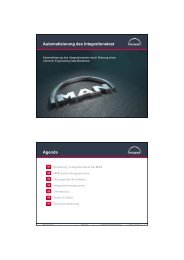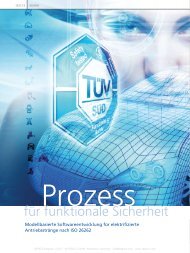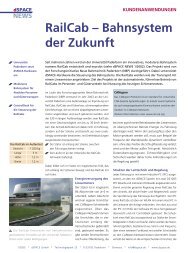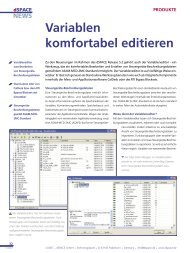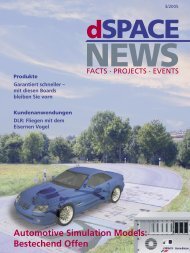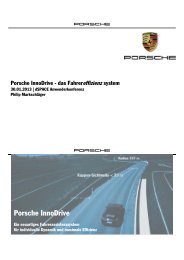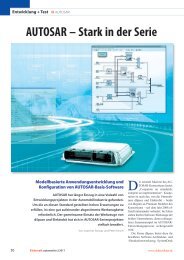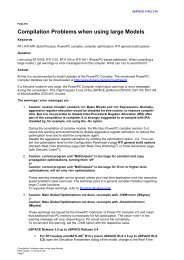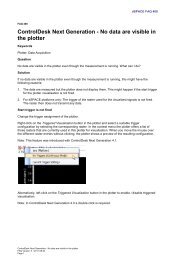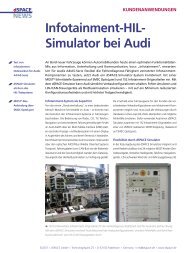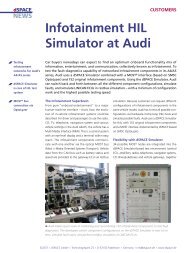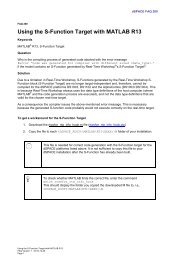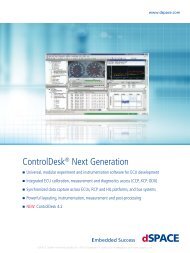magazinE - dSPACE
magazinE - dSPACE
magazinE - dSPACE
You also want an ePaper? Increase the reach of your titles
YUMPU automatically turns print PDFs into web optimized ePapers that Google loves.
Fig. 4: Static monitor view with the decoded<br />
contents of CAN message TIRE_INFO.<br />
predefined CAN message has to be<br />
sent cyclically every 50 ms until<br />
the value goes below the threshold<br />
again (fig. 6). The associated<br />
realtime test implementation is<br />
explained in the text inset.<br />
multi-Tool Can Handling<br />
The versatile configuration options<br />
provided by the RTI CAN Multi<br />
Message Blockset ensure that CAN<br />
communication is configured<br />
consistently across multiple tools.<br />
It covers all the application scenarios<br />
that are typical of ECU testing, such<br />
as interactive experimentation,<br />
CAN monitoring and replay, and<br />
Input_Voltage [Volt]<br />
20<br />
15<br />
10<br />
5<br />
0<br />
CAN-Msg #1<br />
t=500 ms<br />
Fig. 5: Continuous monitor view (here sorted<br />
according to the time received).<br />
automated restbus simulation.<br />
Thus, <strong>dSPACE</strong> provides a complete,<br />
flexible, convenient solution for<br />
editing CAN communication. Such<br />
solutions will be available for other<br />
bus systems in the near future.<br />
50 ms 50 ms<br />
CAN-Msg #2<br />
t=550 ms<br />
CAN-Msg #3<br />
t =600 ms<br />
14,7 Volt<br />
Fig. 6: Example scenario: Monitoring a model signal and its reaction with triggered,<br />
cyclic CAN communication.<br />
t<br />
Real-Time Test implementation of<br />
the Example Test Scenario<br />
In the realtime test, the send data of<br />
the CAN message can be defined freely<br />
via Python programming. This means<br />
that realtime tests can include test<br />
casespecific CAN behavior that is not<br />
intended to be a permanent part of the<br />
realtime model. Realtime testing is<br />
therefore an ideal supplement to the<br />
static (modeldefined) CAN configurations<br />
of the RTI CAN MultiMessage<br />
Blockset. The ability to load several realtime<br />
tests independently of one another<br />
and execute them simultaneously<br />
ensures maximum scalability in implementing<br />
restbus simulation. The<br />
bandwidth reaches from simple, reactive<br />
realtime observers (as in the example)<br />
to extensive test sequences that are<br />
executed completely on the realtime<br />
hardware.<br />
1.<br />
2.<br />
3.<br />
4.<br />
5.<br />
6.<br />
pAGe 45<br />
1. Import real-time testing libraries<br />
(canmmlib, etc.)<br />
2. Generate the variable object of the voltage<br />
to be monitored<br />
3. Select the CAN send controller<br />
4. Define the Send message with the<br />
real-time test<br />
5. Help function for precise time measurement<br />
(for later transmission of CAN messages at<br />
exact time intervals)<br />
6. Real-time test sequence: Check the voltage<br />
once per simulation step and react by sending<br />
a cyclic CAN message



